As an experienced saltwater fisherman, I can attest to the excitement and thrill that comes with casting a line out into the deep blue sea.
With so many types of saltwater fishing to choose from, it can be overwhelming for beginners and even some seasoned fishermen.
In this post, we will be discussing the five main types of saltwater fishing, including surf fishing, inshore fishing, pier fishing, offshore fishing, and deep sea fishing.
Each type of fishing has its unique characteristics, techniques, and gear requirements. So, whether you are a beginner or a seasoned angler, read on to learn more about these types of fishing and how to get started.
If you’re looking to dive deeper into the world of saltwater fishing, be sure to check out my latest post “Diving into Saltwater Fishing: Understanding the Fundamentals” for a comprehensive guide on the basics of this exciting hobby.
Surf Fishing
Surf fishing is one of the most popular types of saltwater fishing, and it involves fishing from the shoreline, typically on sandy beaches.
It can be done both during the day and night, and it is a great way to catch a variety of fish species, including redfish, pompano, sharks, striped bass, and bluefish.
Surf fishing requires specialized gear, including a long surf rod, a sturdy reel, and heavy line.

Recommended Surf Fishing Gear
To get started with surf fishing, you will need the following gear:
Surf Rod: A surf rod is a long, sturdy rod that can be up to 10-14 feet long. It needs to be able to cast heavy baits and lures long distances.
Reel: A surf fishing reel needs to be sturdy enough to handle heavy loads and saltwater. Look for reels with a large spool capacity and a high gear ratio for retrieving line quickly.
Line: Surf fishing requires heavy lines that can withstand the strong waves and currents. Look for braided lines with a test rating of 20-30 pounds.
Bait and Lures: Surf fishing lures need to be heavy and able to cast long distances. Popular lures for surf fishing include spoons, jigs, and plugs. Live bait such as sand fleas and squid can also be effective.
Beach Cart: A surf fishing beach cart is a wheeled cart designed to help anglers transport their fishing equipment, coolers, and other gear across sandy beaches with ease.
Rod Holders: A surf fishing rod holder is a device or attachment that holds fishing rods securely in place while fishing from the shoreline, allowing anglers to have multiple rods set up and ready to catch fish.
If you’re looking to level up your saltwater fishing game, don’t miss out on the comprehensive guide to essential saltwater fishing gear – it’s packed with tips and insights that will help you catch more fish!
Surf Fishing Techniques
Surf fishing techniques can vary depending on the location and the type of fish you are targeting. Here are some popular techniques to try:
Bottom Fishing: This involves casting your bait or lure into the surf and letting it sit on the bottom. This technique is effective for catching bottom-dwelling species such as redfish and flounder.
Casting and Retrieving: This involves casting your bait or lure out into the surf and retrieving it back in. This technique is effective for catching species such as striped bass and bluefish.
Drift Fishing: This involves casting your bait or lure out into the surf and allowing it to drift with the current. This technique is effective for catching species such as pompano and whiting.
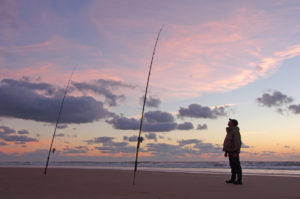
Inshore Fishing
Inshore fishing takes place in the shallow waters near the shore, typically in bays, estuaries, and mangroves.
This type of fishing can be done from a boat or from the shore, and it is a great way to catch a variety of fish species, including redfish, whiting, snook, black fish, and trout
Inshore fishing requires specialized gear, including a light to medium rod, a spinning reel, and light line.
Recommended Inshore Fishing Gear
To get started with inshore fishing, you will need the following gear:
Rod: An inshore fishing rod should be light to medium in power and around 6-7 feet long. It should be able to cast small lures and baits accurately.
Reel: A spinning reel is the best option for inshore fishing. Look for a reel with a smooth drag system and a high gear ratio.
Line: Inshore fishing requires light lines with a test rating of 8-15 pounds. Monofilament or fluorocarbon lines are commonly used for inshore fishing.
Bait and Lures: Inshore fishing lures should mimic the prey that the target species feed on. Popular lures include soft plastics, topwater plugs, and suspending jerkbaits. Live bait such as shrimp, mullet, and pinfish can also be effective.
Live Well: A live well in saltwater fishing is a compartment on a boat or a container that holds live baitfish, allowing anglers to keep them alive and in good condition for extended periods while out at fishing.
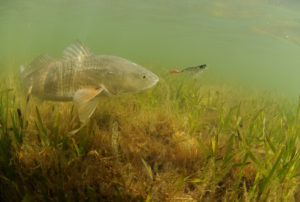
Inshore Fishing Techniques
Inshore fishing techniques can vary depending on the species and the location. Here are some popular techniques to try:
Casting and Retrieving: This involves casting your lure near structures such as docks, mangroves, and oyster beds, and retrieving it back in with various speeds and pauses. This technique is effective for targeting species such as snook and redfish.
Sight Fishing: In clear waters, sight fishing allows you to spot fish cruising or feeding near the surface. Use polarized sunglasses to spot fish and cast your lure ahead of them to entice a strike. This technique is commonly used for targeting species like Black Fish (Triple Tail) and Speckled Trout.
Drifting: Drifting is an effective technique when fishing in areas with strong currents. Use live bait or soft plastics on a jighead and let them drift naturally with the current. This technique is popular for targeting species such as flounder and sheepshead.
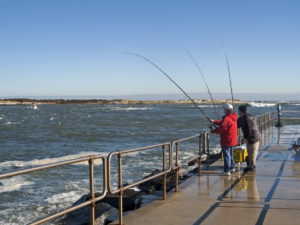
Pier Fishing
Pier fishing is a convenient and accessible way to enjoy saltwater fishing without the need for a boat.
It involves fishing from a pier or a jetty, which extends into the water.
Pier fishing can yield a wide variety of species, including Black Drum, Sheepshead, Spanish mackerel, and even larger game fish like Tarpon and Sharks.
Pier fishing requires specific gear, including a medium to heavy rod, a spinning reel, and a variety of rigs and tackle.
Recommended Pier Fishing Gear
To get started with pier fishing, you will need the following gear:
Rod: A medium to heavy power rod around 7-9 feet long is suitable for pier fishing. The length will help you cast further and handle larger fish.
Reel: A spinning reel with a smooth drag system and a high gear ratio is recommended for pier fishing. Ensure that the reel can handle saltwater conditions and has enough line capacity.
Line: Use a monofilament or braided line with a test rating between 12-30 pounds, depending on the target species and the structure around the pier.
Rigs and Tackle: Pier fishing often requires different rigs and tackle setups depending on the species you are targeting. Common setups include bottom rigs, fishfinder rigs, and float rigs. Carry a variety of hooks, sinkers, and swivels to adapt to different fishing conditions.
Live Well Bucket: A live well Bucket is a container that holds live baitfish, allowing anglers to keep them alive and in good condition for extended periods while out at fishing.
Fishing Cart: A fishing cart is essential for pier fishing as it provides a convenient way to transport all your gear, without the need for multiple trips back and forth. It helps you save time and energy, allowing you to focus on the fishing experience and enjoy your time on the pier.
Pier Fishing Techniques
Pier fishing techniques can vary depending on the structure and the species you are targeting. Here are some popular techniques to try:
Bottom Fishing: This involves casting your baited rig or lure towards the pilings or structures beneath the pier and letting it sink to the bottom. This technique is effective for catching bottom-dwelling species such as Black Drum.
Jigging: Use jigs or artificial lures that imitate small baitfish and jig them up and down near the pier pilings. This technique is a great way to catch Flounder.
Float Fishing: Float fishing involves suspending bait or live bait under a float at various depths. This technique is effective for targeting species such as pompano that feed near the surface or mid-water.
If you’re a saltwater fishing enthusiast looking to up your game, don’t miss out on our post on Fishing Tips: Key Advice for Saltwater Fishing Enthusiasts – it’s packed with valuable insights that will help you improve your technique and make the most of your time on the water!
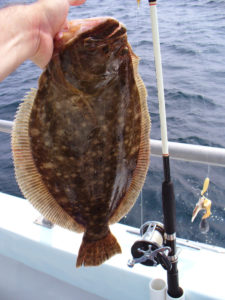
Offshore Fishing
Offshore fishing takes place in deeper waters, typically beyond the sight of land. It involves traveling several miles offshore and targeting larger game fish such as snapper and grouper.
Offshore fishing requires specialized equipment and a boat capable of handling rough waters and long distances from shore.
Recommended Offshore Fishing Gear
To get started with offshore fishing, you will need the following gear:
Rod: Offshore fishing requires heavy-duty rods designed to handle the power and weight of large game fish. Look for rods with a heavy power rating and a length of 6-7 feet for trolling or stand-up fishing.
Reel: Choose a high-quality reel with a strong drag system and a high line capacity. For offshore fishing, conventional reels or large spinning reels are commonly used.
Line: Use braided lines with a test rating of 30-80 pounds, depending on the target species. Braided lines offer excellent strength and sensitivity, allowing you to detect subtle bites and handle powerful fish.
Terminal Tackle: Offshore fishing often requires specialized terminal tackle such as swivels, leaders, and heavy-duty hooks. Make sure to use high-quality saltwater-resistant tackle to withstand the harsh offshore environment.

Offshore Techniques
Offshore fishing techniques can vary depending on the target species and the fishing location. Here are some popular techniques to try:
Trolling: Trolling involves dragging lures or rigged baits behind the boat at various depths and speeds to attract predatory fish. Use trolling lures such as skirted baits, diving plugs, and artificial squids.
Bottom Fishing: When targeting species that dwell near the ocean floor, such as grouper or snapper, anchor the boat over a productive fishing spot and drop baited rigs with heavy sinkers. Use cut bait, live bait, or squid as bait.
Deep Dropping: Deep dropping is a technique used to target deep-water species like tilefish or barrelfish. It involves using electric reels to drop baited rigs with heavy weights to the ocean floor, often at depths of hundreds or even thousands of feet.
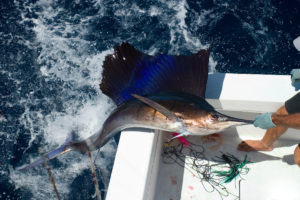
Deep Sea Fishing
Deep sea fishing, also known as bluewater fishing, takes place in the open ocean, far from land.
It involves venturing into deep waters to target large pelagic species such as tuna, marlin, sailfish, and sharks.
Deep sea fishing requires advanced equipment, a capable boat, and experienced anglers.
Recommended Deep Sea Fishing Gear
To engage in deep sea fishing, you will need the following gear:
Rod: Deep sea fishing rods are typically long, sturdy, and built for fighting powerful fish. Look for rods with heavy power and a length of 6-7 feet for stand-up or trolling fishing.
Reel: Choose a high-quality reel with a large line capacity, a strong drag system, and the ability to handle heavy lines. Depending on the target species and fishing technique, you may opt for conventional reels or specialized big game reels.
Line: Use heavy-duty braided lines with a test rating of 50-100 pounds or more, depending on the target species. Braided lines offer superior strength, abrasion resistance, and sensitivity.
Terminal Tackle: Deep sea fishing often requires specialized terminal tackle such as large hooks, heavy-duty swivels, and leaders. Use high-quality saltwater-resistant tackle to withstand the demanding offshore environment.

Deep Sea Fishing Techniques
Deep sea fishing techniques vary depending on the target species and the fishing location. Here are some popular techniques to try:
Trolling: Trolling involves dragging lures or rigged baits behind the boat at various speeds to entice predatory fish. Use large trolling lures such as artificial squids, jet heads, and skirted baits.
Chunking: Chunking is a technique used to attract and target large predatory fish. It involves cutting chunks of baitfish, such as mackerel or bonito, and dispersing them in the water to create a scent trail. Place a hooked chunk of bait on a large circle hook and drop it into the water to entice fish to bite.
Live Bait Fishing: Using live bait is a highly effective technique for deep sea fishing. Species such as tuna and marlin are often targeted using live baitfish, such as mackerel, herring, or bonito. Rig the live baitfish with a circle hook and either free-line it or use a balloon or a downrigger to present it at the desired depth.
Jigging: Jigging involves dropping heavy metal jigs to the depths and then rapidly jerking the rod to imitate a wounded baitfish. This technique is effective for targeting species such as amberjack, grouper, and snapper.
Drifting: Drifting involves drifting with the currents while presenting bait or lures. This technique is commonly used for species such as mahi-mahi and sailfish. Use natural baits or brightly colored lures that mimic the prey of the target species.

Off Shore Fishing Vs. Deep Sea Fishing
Offshore fishing typically refers to fishing that takes place in waters beyond the immediate coastal areas, often within a few miles to several dozen miles from the shore.
It usually involves targeting fish species that inhabit the continental shelf or offshore structures like snapper and grouper.
On the other hand, deep-sea fishing specifically refers to fishing in the deeper parts of the ocean, typically in waters several hundred feet to several thousand feet deep.
Deep-sea fishing often involves targeting larger pelagic species that dwell in the open ocean, such as marlin, tuna, and swordfish, and may require specialized equipment and techniques due to the depths and conditions encountered.

Just Go Fishing
Saltwater fishing offers a wide range of exciting opportunities and experiences.
Whether you prefer the thrill of casting from the shoreline or venturing far offshore, each type of saltwater fishing presents its own unique challenges and rewards.
By selecting the appropriate gear and learning the specific techniques associated with each type of fishing, you can enhance your chances of success and create unforgettable memories on the water.
So, grab your gear, choose your preferred type of saltwater fishing, and get ready for an incredible angling adventure!
